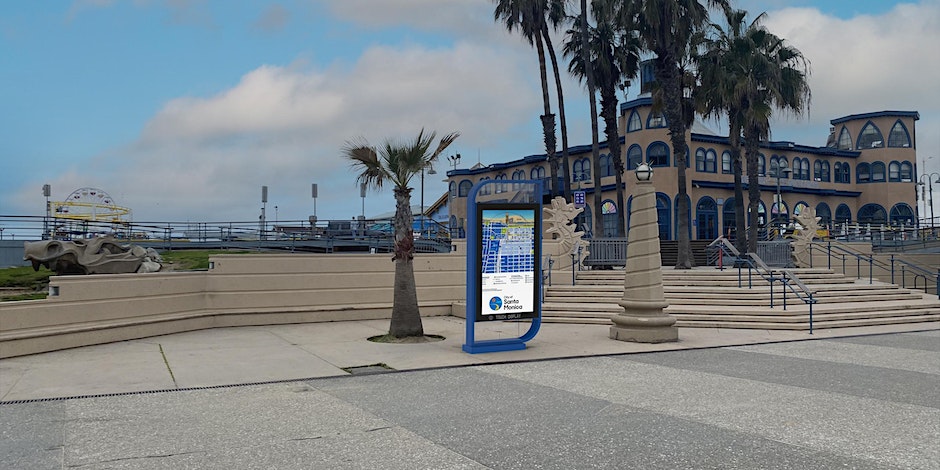Advertising Averse Santa Monica Embraces Digital Kiosks


May 16, 2023 — “The Future is Here,” City officials announced this week, and Santa Monicans next month can get a first hand look at the kiosks that will spring up on commercial sidewalks across the city.
Unanimously approved by the City Council, the state-of-the-art digital wayfinding kiosks “will include wifi, maps, business directory, city announcements, emergency services, and much more,” officials said.
Included in the “much more” are digital ads that will serve as billboards in a City that banned them nearly 40 years ago and cameras that will capture the images of pedestrians who pass by.
The kiosks — which will be about 8 feet tall and nearly 4 feet wide — drew little pushback from residents or the City Council, who viewed the prospect of placing as many as 50 kiosks in Santa Monica commercial areas as a financial windfall.
Instead, almost all of the public comment and debate centered on which company — Big Outdoor or IKE — should be awarded the lucrative 20-year contract expected to pump an estimated $14 million a year into the City’s coffers.
After two meetings, threats of litigation and intensive lobbying, the Council awarded the contract to Big Outdoor, which threw in a $4 million signing bonus.
“This new community messaging and advertising program provides a benefit to residents and visitors while also creating a new much-needed revenue source that can support community programs,” said Mayor Gleam Davis shortly after the Council approved the program last December.
“The City and the selected vendor look forward to engaging the community as the kiosk program launches,” Davis said.
While Santa Monica embraced kiosks, other cities and their residents have either opposed similar programs or raised concerns about their impact and usefulness.
Last month, the San Diego Planning Commission voted 4-2 to recommend the City Council “amend its sign ordinance to allow for at least 50 digital advertising and wayfinding kiosks downtown,” according to the San Diego Reader.
Commission chair Bill Hofman, who cast one of the two dissenting votes, said he didn’t see the need for kiosks in a cell phone-dependent society.
“I believe this will not be a substitute for cell phones,” Hofman said. “Cell phones are far more convenient. You don’t have to walk two blocks to look at them and a cell phone can do everything that these kiosks will do.”
According to a Wall Street Journal article published in April, marketers spent $9 billion in the U.S. last year on out-of-home advertising, which includes digital billboards and kiosks, a 17 percent increase since 2015.
“Proponents see digital signs as a highly effective marketing medium that commands consumers’ attention and brings in revenue for cities,” the article said.
“Marketers are rapidly shifting their out-of-home spending toward digital signs because messages there can be easily tailored,” the article said. “Digital billboards can also display multiple ads, meaning they can generate more revenue.”
Meanwhile, critics argue that “they are unfriendly to the environment because of their energy usage and that they contribute to light pollution.”
“It’s a Trojan horse,” Lisa Ross, chair of the Sierra Club’s San Diego Chapter, which opposes the proposal, told the Journal. “We think they’re putting revenue ahead of the best interest of the public.”
In its article, The Reader noted that “some say San Diego, a pioneer in warding off once-static billboards, has become a target of visual advertisers.”
“We’re sort of a pristine little gem here,” Pamela Wilson, the founder of Scenic San Diego told the Commission, urging it to vote no.
“You don’t see this kind of thing, you don’t see more billboards,” Wilson said. “There are no digital billboards.”
And there are few, if any billboards, left in Santa Monica after the Council banned all but those already standing in 1985.
By 2009, when digital billboards were sprouting across Los Angeles, Santa Monica was held up as a model that had refused to sell out to corporate interests.
But times have changed. By the time the Council unanimously approved the kiosk program, the City was strapped for cash — having settled a sexual abuse lawsuit for nearly $230 million and facing an unfunded pension liability of nearly half a billion dollars.
Santa Monica will hold three open houses that offer a chance “to experience and interact with the kiosks in person.”
The City will seek “feedback on the proposed kiosk design, locations, and what information you think should be available in the kiosks so that they are user-friendly and relevant for all Santa Monicans.”
“These kiosks,” the invitation to attend says, “will enhance residents’ and visitors’ experience of our city and provide added safety to Downtown Santa Monica and beyond.”
The open houses will take place Friday, June 2 from 3 to 7 p.m.; Saturday, June 3 at from 10 a.m. to 2 p.m., and Thursday, June 8 from 2 to 6 p.m. at Bergamot Station ARTS CENTER, 2525 Michigan Avenue. To RSVP click here
By Jorge Casuso / Santa Monica LOOKOUT
